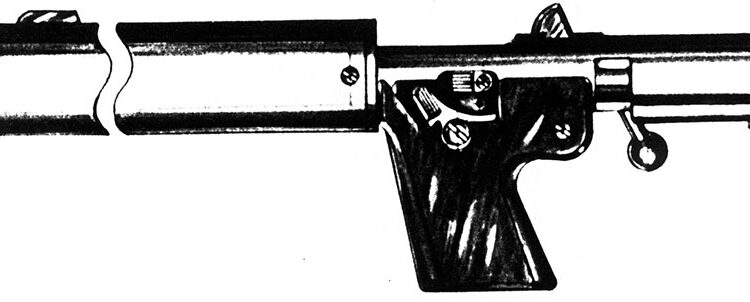By J. David Truby
It’s RKI Quiz Time.
1.) What looks like a fat, oversized zip gun?
2.) Although less than 2800 were produced, what handgun killed far more German officers in WWII than the millions of our 1911A1 .45s?
3.)What ancient originals are the UK’s SAS lads still using to “quietly operate” in Northern Ireland?
A. THE WELROD!
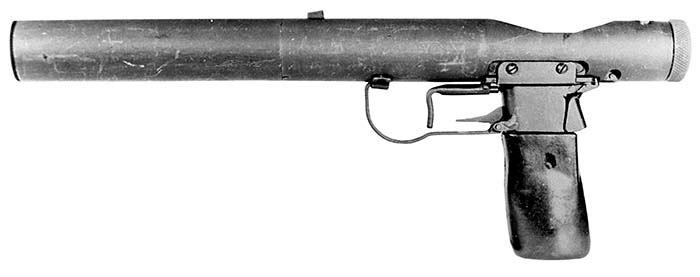
That’s not some modern soldering technique, it’s the name of this heavy, ugly, silenced single shot pistol of WWII vintage that has been accountable for the demise of a lot of Britain’s enemies, in war, peace and semi-war. Although primarily a British weapon, the Welrod was also used by our OSS people in WWII.
The OSS description of the 9mm Welrod was delightfully enigmatic, calling it “a silent single shot pistol intended for use by specially trained operators for specific tasks”. According to the British product literature, i.e, their user’s manual, their Welrod is quite the special mission pistol:
This weapon…is silent, reliable in action and easy to conceal. It is accurate up to 30 yards in daylight or 20 yards on a fairly light night, but is most effective when fired in contact with the target.
The last line, gentle reader, means in direct contact with the target, as in an ultra close-up assassination.
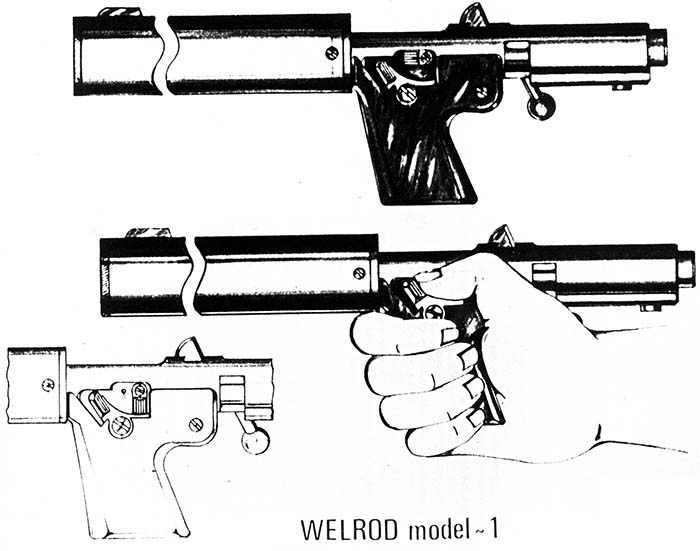
Their user manual goes on to instruct, “..with the muzzle directly against the target…there is no question of any special training.”
A colleague of mine with dirty war credentials introduced me to an elderly British Para who knew the Welrod well, having used it during WWII when he was an SOE operative in Yugoslavia, then later when he was with SAS during the unpleasantness in Malaysia.
“It’s a killer’s pistol, nothing very glamorous or exciting. You get in close to your target, tight as you can, and let him have it,” he said with blunt reality.
“The farthest I ever hit with one was 10 meters, but the old Welrod worked fine. People could hear the bang, but it never gave me away. That sound moderator is a good disguiser of where shots come from. Never any ball-ups; it’s a good, simple, workable rig.”
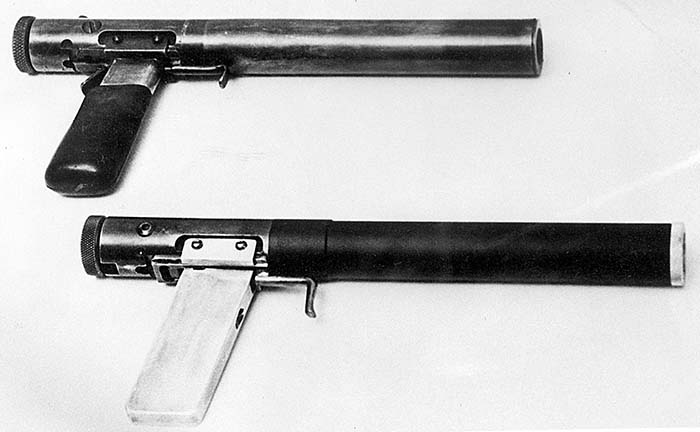
So, what is this over-aged pistol all about? The Welrod is a manually operated single shot, WWII pistol built around a baffled, integral suppressor unit and magazine.
The suppressor itself is a series of self-sealing metal, plus fiber, leather or rubber washers. The non- metallic washers close after each round passes through, effectively delaying the passage of noisy gases. Although the sound reduction system is very effective, somewhere between 25 and 35 dB, the efficiency of the original system deteriorates quickly after twenty shots or so due to the enlargement of the washer holes from the rounds passing through.
The pistol is designed for replacement of the worn-out parts or the entire weapon can be discarded. According to operational stories, though, that latter case is very rare.
“When I was in Northern Ireland in 1980, our section had a Welrod that dated to field use in 1944,” says one former SAS officer. “The original baffles had been replaced by a newer composition material and there’s no way of telling how often that had been done. We used that weapon and it still worked very effectively.”
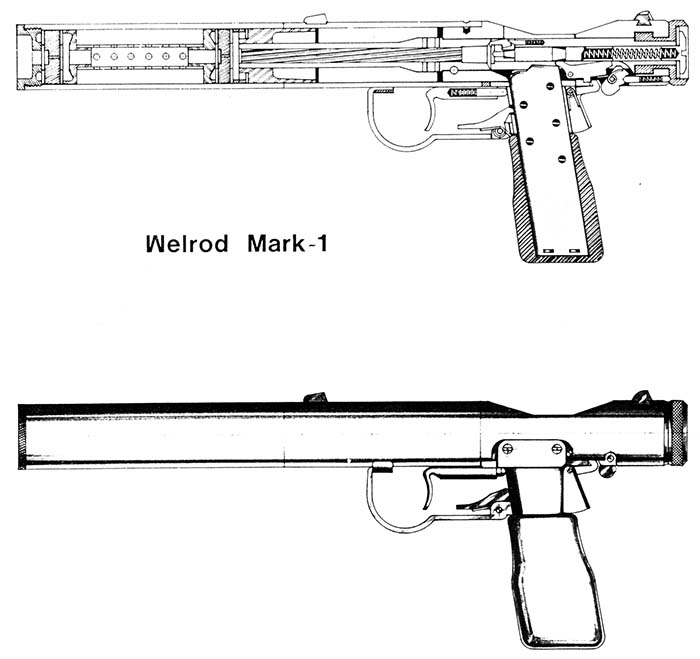
According to the international ordnance expert, consultant and icon Jack Krcma, who has extensive experience with the Welrod, “On being fired, the gun produces a report about equal to a .22 short being fired from a rifle. This report is followed either by a prolonged hissing sound as the gas escapes through the cork in the suppressor, or by a more rapid, duller hiss when the gas under pressure remains trapped in the suppressor and escapes upon opening the bolt.”
A WWII brainstorm of Winston Churchill’s so-called “Black Toy Box” special warfare scientists, the Welrod was produced both in 9mm and .32 caliber, with the 9mm version known as the Mk I and the smaller model, the Mk II. The physical dimensions of the 9mm Welrod include a 14 3/8-inch length with a weight of 42 1/2 ounces. The suppressor unit is 5 inches long, with a 1 3/8-inch diameter. The weapon has a magazine containing six rounds of 9mm ammo. This pistol’s muzzle velocity is 1000 fps.
The Welrod Mk II is a .32 caliber model with an overall length of 12 1/2 inches and weighing 32 ounces. Its magazine holds five rounds, and the weapon has a muzzle velocity of 920 fps. According to British data, the accuracy of this model is sufficient to give 5-inch groups at ranges up to 10 yards. According to the manual, the recommended operational range is 5 to 7 yards.
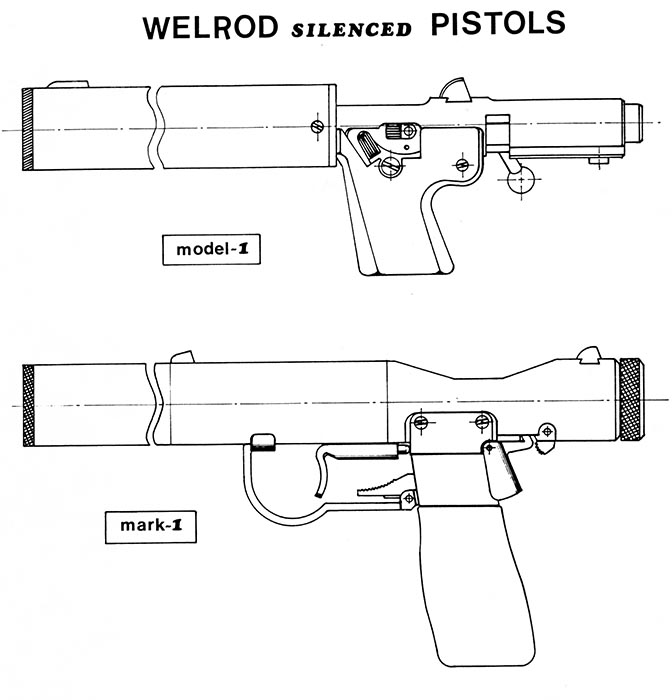
There was little about the Welrod that was fancy, Jack Krcma says, “The rifling is five groove with a left hand twist. The unit I first examined had a fixed square notch front sight with luminous centerline and a rear sight with a fixed blade and luminous spot. The standard finish for all Welrods is a Parkerized one.”
Each Welrod’s sights were coated with a radioactive paint for night use, while the silencer’s muzzle endcap was hollowed to a depression to further reduce sound signature when the weapon was fired in direct contact with the target.
The only major external differences between the 9mm and 32 caliber Welrods are the smaller physical size of the .32 and the fact that it does not have a trigger guard. Internally, the two pistols are quite different, though, as the 9mm model has a two-part suppressor barrel section, while the .32 has a single section.
The 9mm original production Welrod’s suppressor contains two rubber baffles, while the .32 model has three. Internally, these are beyond the pistol barrel. The barrel has a series of 20 holes drilled around its periphery, which are positioned in the five rifling grooves and vent to the surrounding expansion chamber. This chamber is separated from the front suppressor section by a baffle that has 12 holes. The suppressor section, extending beyond the barrel muzzle, is 4 inches long and contains a series of intermittently spaced metal and rubber baffles.
The 9mm Welrod suppressor consists of two sections, front and rear. The rear portion contains the gun barrel, which has sixteen bleed holes at its breech end. The gun barrel is surrounded by a tube that, together with the threaded front bushing, forms an expansion chamber for the gases escaping through the bleed holes. The front portion of the pistol barrel is essentially the weapon’s suppressor, attaching to the pistol by means of a threaded bushing. The inside of this suppressor section contains a series of metal, rubber and felt baffles separated by a perforated spool-like steel spacer.
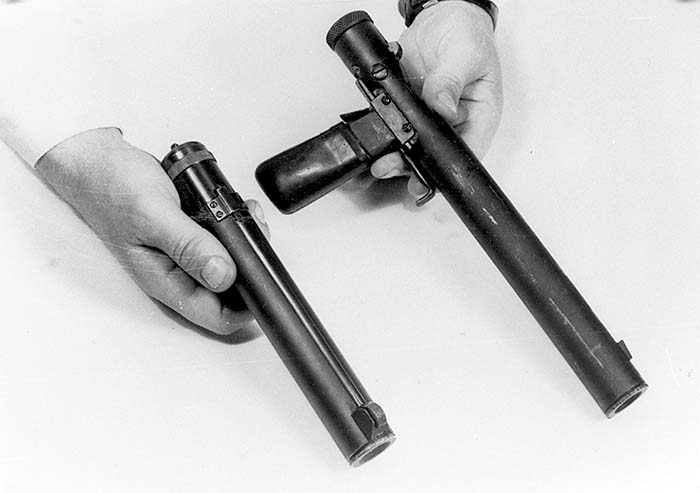
The initial washers for the WWII suppressors were stamped from oil-soaked leather. However, this was soon stopped as tests showed that oil heated by the weapon firing produced smoke. Later washers were made of rubber, cork or of bronze screening.
One of the purposes of the Welrod was to be a weapon that could be issued to indignant local resistance fighters on assassination missions in occupied territories. Thus, the weapon’s basic operation had to be uncomplicated, which is why the Welrod is a simple, bolt action, single shot pistol.
To operate the weapon, you insert a loaded magazine all the way home. Twist the knurled knob at the breech a quarter turn to the left and pull it back. When you push this knob forward it tips a cartridge from the magazine into the chamber. Lock the Welrod’s bolt by turning that knob one quarter to the right. The closing stroke of the bolt also cocks the weapon. After the Welrod is fired, you withdraw the bolt, which extracts and ejects the fired case through the top of the weapon. Repeat the simple process, and that’s how it works.
Generally, a professional will use two hands to fire the Welrod, except for extremely close-in targets. One hand grips the outer silencer tube as far forward as is convenient or comfortable, while the pistol grip is held in the firing hand, just tightly enough to compress the safety catch. For distances beyond 10 yards the manual suggests the operator tuck the outer arm elbow as close to the body as possible.
That’s the what, the why, and the how. The rest is a bit more complicated. The actual ancestry of the Welrod still remains buried in the classified murk of British wartime security, even now, nearly 60 years of history later. Possibly, though, this is because these antique weapons are still killing people, e.g. in northern Ireland.
Efforts to research the genesis of this classic piece of military ordnance mostly arrive from personal contacts rather than official records, which remain “sealed, destroyed, or lost.” In a conversation some years ago with Major Frank W.A. Hobart, a retired British officer and premier ordnance scholar, he told me “The original models were produced in one of our factories near Wells, and since your OSS was going to use them as well as our chaps, someone tagged the American slang word ‘rod’ (meaning gun) on the end of it. Thus, the Welrod.”
The term Welrod also has a genesis with England’s Welwyn Herts Laboratories, where many nasty weapons and gadgets were developed for the SOE. The Welrod’s designer was a British ordnance officer who was assigned the wartime code name of “Major Dolphin.” Neither Frank Hobart nor Jack Krcma knew the real name of this man.
In his well researched book THE PUMBER’S KITCHEN, Don McLean reports, “They (the British) had a Station IX where they established a rather large machine shop for the purpose of carrying out research and small scale production of a number of silent weapons. From this group a notable silent gun was forthcoming, namely the Welrod.”
Jack Krcma also confirmed that Station IX was located in Wells, just as Frank Hobart had said.
The actual tooling, production and assembly of the Welrod pistols was performed under great secrecy at the Birmingham Small Arms Company factory in Small Heath, Birmingham. There are no specific identification marks on the weapons except for a 5 pointed star and small square which indicated the BSA firm. The small marks are located at the rear bottom end of the cylindrical receiver portion along with the weapon’s serial number.
A British military critique of the Welrod during field trails at BSA concluded, “The weapon is excellent…having been designed around the silencer unit it eliminates much of the objectionable noise. It does require two hands for operation as it is a heavy weapon, also it is cumbersome in the reloading, and subsequent shots cannot be taken rapidly.” On the whole, the evaluation was good, concluding, “It is felt that his weapon has a great deal of merit to organizations such as the commando units and the SO(E).”
Although the Welrod was a British weapon, the U.S. did purchase and use some quantity of the pistols. There is no consensus as to when the first Welrod was brought into the States for trials, but there is some evidence it was early Spring of 1943. The Welrod did not appear in official U.S. reports until that Summer, when it was tested in July at H.P White’s Research Laboratory near Aberdeen Proving Ground. An excerpt from the report for that day notes:
Following a delicious lunch of goat, the group adjourned to a firing range and the same weapons used at Aberdeen were demonstrated again.. Major Fairborne (sic) and Commander Bird were most impressed.. The silencer cut the sound down by about 35 dB.
“Fairborne” was the famed British Major W.E. Fairbairn of police and commando reputation who had more than a passing interest in silent weapons. According to the British military historian William Leathers, “Fairbairn was most likely the high ranking British government courier for the weapon… a man who could understand it, use it and probably sell it to your people (the OSS).” Leathers reported that a test Welrod was brought to the USA in April or May of 1943 by “a field grade officer of some repute.” Fairbairn?
The official American record, though, picks up when this British contribution to special warfare weaponry is noted. In the OSS, responsibility for the acquisition of silenced weapons was assigned to Division 19, headed by Dr. Harris M. Chadwell. Dr. Chadwell was Chief of the National Defense Research Committee, the official cover name for the folks who provided the nasty killing weapons.
On 16 August 1943, a meeting of the British liaison and American OSS researchers held at the Maryland Research Laboratory covered silenced weapons, and the Welrod rated high in the minds of all participants. The report concluded, “It was felt that for that special type of mission, it was the best available design and the U.S. should proceed with purchase of production model Welrods rather than trying for a home-built version”.
Most of the operational responsibility for these weapons was held by Vannevar Bush and Stanley Lovell, an OSS legend in his own right. Given the silenced pistol need, Lovell had been working with an old Army friend. Col. R.R. Studler, a noted small arms authority, on silenced weapons procurement. Although Bush, Lovell, and others had been working on obtaining silencer-equipped weapons since early in the war, this was the first official “blessing” for the particular search…a quiet assassination weapon.
A large scale, formal test was made at MRL late that September. According to unofficial reports, the Welrod did very well in the competitive firings and a limited procurement was ordered, as Bush, Chadwell and Lovell had requested weeks earlier. Always the practical engineer, Lovell wrote. “There seems little sense in wasting time or effort as the British obviously have a superior design here…(The Welrod)…Suggest we provide funds for additional experimentation on our .22 silenced pistols and on the submachine gun models.”
In a memo dated 18 September 1943, Dr. Bush wrote, “Welrod very satisfactory as silenced weapon… British have 1000 in production.” He requested immediate procurement of 200, followed by a run of 50 per month by the U.S. Bureau of Ordnance. He asked that these future U.S. produced weapons be modified to .45 ACP. He also noted it would be satisfactory to purchase the modified weapons from the British if production would be more efficient there.
However, as other OSS Division 19 scientists were already at work on several projects involving modified .45 caliber pistols, e.g., “The Bigot,” that modification request was dropped.
On 8 October 1943, the British Security Co-Ordination’s Engineering officer, Maj. W.M. Fox, arranged orders for “hand delivery to Doctors Bush and Chadwell by safe, armed courier” of a copy of “description and operational instruction for the Welrod, which my be of interest and use to you.” The model involved was the .32 caliber MkII, which the OSS was testing.
Chadwell, Bush and Lovell praised the test Welrod and its performance over other units, including three OSS models. They reported, “A completely independent line of investigation has been carried out through Dr. King on silencing guns… You will notice that the Welrod is mentioned on page 3. The model fired at that time was furnished by Colonel Studler of Army Ordnance.”
Indeed, the Welrod was tested, re-tested and continues to be tested, even years later, as seems to be SOP with silenced weapons. In one 1943 test, conducted by Division 19 personnel, under the supervision of Stanley Lovell and Col. Studler, their Welrod recorded a 118 dB pulse. A 1965 test of a rebaffled Welrod by officials at Aberdeen Proving Ground recorded a 115 dB reading, a drop of 35 from the unsilenced model. The lowest figure I have noted was conducted with a rebaffled Welrod Mark I in 1977. The reading was 110 with the 9mm model. The lowest reading I have noted for the .32 caliber Mark II is 103 dB.
According to a U.S. Army report on a Welrod test in 1985, “On one unit was recorded a drop of 30 dB.”
In a less scientific but reliable field test, the effectiveness of the suppressor is such that at 50 meters from the weapon, I could not readily identify the sound as a gunshot when my associate fired the Welrod some 30 feet over my head and down range. Also, we tested a vintage WWII model in 1980, replacing the original packing with as nearly the same baffling material (cork) as we could utilize. The result was a 35 dB drop.
When the Department of the Army scientists tested another totally original Welrod at the Frankford Arsenal in 1968, their report noted a maximum sound pulse of 122 dB, then described the sound signature as “a sharp, snappy crack.”
I asked an OSS veteran who had used a Welrod in Europe about this, and he said the rubber baffles in the Frankford test weapon were probably old and brittle with large blow holes, instead of having a tight wipe fit. “I’d have to describe the operational Welrod of that period (WWII) as having a sound signature more like the primer ignition of a .22 short followed by a slight hiss,” he said.
Back in 1943, when it really mattered to the special mission hungry OSS, the Welrod passed all its official tests easily. The OSS officials concluded that silenced weapons had a definite role in their arsenal. In England, this conclusion was academic, considering that both SOE and the various British Commando units had already been using these silenced pistols in the field for nearly six months.
The only rap the American officers who used the Welrod leveled at it was that it required two hands for ranges over 10 yards, plus the slow, manual reloading. Lovel’s response noted, “Please consider what missions the user of the Welrod is assigned and at what ranges he will be firing. It is not an ordinary combat gun; it has special mission use where some limitations exist to allow for other advantages. Please think this through operationally.” Bush was more pithy when he wrote to Chadwell, “This (the Welrod) is a nice weapon for gangsters. Think about that.” He knew, of course, of its murderous intent.
Because the missions in which silenced weapons are used generally are not the types of action personnel, units, or countries desire to share in the public spotlight, it is rare that cameras, reporters, or other talkative sources are around to record these deadly moments. Action photos of silenced weapons in the field are rare. Only somewhat less rare are the war stories of their use.
“The mortality rate is awesomely high among people who go on the types of mission in which silenced weapons are used,” says former Special Forces NCO Ted Bell, a two-tour Vietnam vet who has done attached service with other organizations and has a personal appreciation for these jobs.
According to the military historian Maj. Frederick Myatt, there are situations, missions, and times when relative silence is not only desirable, but also deadly. As Maj. Myatt writes about WWII, “…special operations people..sometimes need a silenced pistol and it was for their use that the Welrod was produced.”
The men and women who used the Welrod had praise for it. A man who knew many of these users, the last Canadian intelligence operative, John A. Minnery, noted, “The favorite weapon of the day was the silenced Welrod in .32 caliber and 9mm. Both these weapons were quite effective and took their toll in France and the low countries.”
Len Jameson was an SOE officer in Europe during 1944-45 and knew the Welrod well. Now retired in Australia, he writes, “We used crossbows and quieted rifles mostly for sentry work. The Welrod was a fine weapon to send into town with an agent if you wanted to bump off a German officer or a Gestapo bully. Our Resistance allies made good use of the ones we gave them.”
One Jameson story involved the elimination of an informer, whom they took out in a crowded inn in German-occupied France. “We’d given a Welrod to one of our most loyal boys and he smuggled it into the inn at great risk to himself,” Jameson told me. “A bunch of his mates crowded around talking, then bellied up to the bar, surrounding the mouthy mark we were hitting. The lad stuck the Welrod right up into the collaborator’s chest and put a round through his heart. Honest to God, they said nobody heard a sound. They propped the body into a chair and left by ones and twos during the next ten minutes. The Herberts (Germans) didn’t notice anything was wrong for hours.”
Another Welrod pistol, now in the collection of the Nationalmuseet of Denmark, was used by a Danish underground group to liquidate Nazi officials and local collaborators during the war. Code-named Holger Danske, the group was very successful in their use of arms dropped by the British. One of their foremost leaders during the highly dangerous and deadly Welrod missions was Capt. Ole Geisler, an SOE agent who carried the British code name “Axel.” His personal Welrod, a MkII, is on display in the Danish museum today. It took out nearly two dozen German officers and officials in 1944 and 1945.
A former OSS agent, Col. John S. Wood, said he had carried a Welrod in France and used it to eliminate several German officers.
In this line, the OSS supply list is interesting. The “normal” OSS ordnance materials issued to OSS agent William J. Morgan for his assignment behind German lines included the following; A .32 Welrod pistol; an M1911A1 .45 pistol; a .22 caliber silenced HD pistol; an ordinary blackjack; a spring-snapper cosh (blackjack); a lapel dagger; cameras and lots of film; two sleeping bags; a large box of time pencils and other detonating devices; an army blanket; a switchblade knife; a commando knife; a plastic pouch to cover explosives, and condoms to cover the detonators.
According to cogent military officers, Welrods are still on active duty in the continuing dirty little wars. Retired SAS Sergeant Brian Sykes told me, “I know for a fact they were used in Ireland and Korea because I was there and saw them. I know some of our observers in Vietnam had second-generation, locally made Welrods when they went on the black missions with your Special Forces people”.
Yet, according to two sources in Britain, the Welrod has not been operational for years. Noted ordnance research Colin Greenwood wrote in the 80s. “The Welrod is not in use today”. Another source, a weapons expert from the Imperial War Museum in London says, “I don’t think the Welrod has been used ‘officially’ for some considerable time, certainly not in Ireland or the Falklands. It is relatively obsolete compared to recent, more sophisticated weapons.”
By contrast, though, that combat veteran of WWII, the OSS, CIA, and only God knows how many other operations, Jack Krcma notes, “I am certain Welrods saw action in Korea, Malaysia, Ireland, Vietnam and in the Falklands. It is still a very fine, very effective weapon.”
It is also a very rare collector’s item, as few as 30 may still exist outside of museums and special mission armories. According to Krcma, “There are very, very few original Welrods on the market today, even for official collection curators to purchase. The prices will range from $4000 to $25,000 for each weapon”.
With that in mind, did you wonder about the price to produce each Welrod during WWII? Estimates range from $15 to $25 per weapon. Today, that pistol sells for up to $25,000.
That’s not bad price appreciation for an ugly, old pistol.
WELROD BIBLOGRAPHY
I PUBLICATIONS
Foot, M.R.D.
SOE IN FRANCE HMSO, 1966
Huebner, Siegfried F.
SILENCERS FOR HAND FIREARMS
Paladin Press, 1976
Ladd, James and Keith Melton.
CLANDESTINE WARFARE
Guild Publishing, 1988
Lovell, Stanley,
OF SPIES & STRATAGEMS.
Prentice Hall, 1963
McLean, Donald B.
THE PLUMBER’S KITCHEN.
Normount Technical Publications, 1975
Minnery, John A.
FIREARMS SILENCERS, Vol II
Desert Publications, 1981
The Silent Canadians,
THE GUNRUNNERS,
June 1973
Joe Ramos,
AMERICAN TOOLS OF INTRIGUE
Desert Publications,
1980
Myatt, Maj. Frederick,
MODERN SMALL ARMS,
Crescent Books, 1978
Office of Scientific Research & Development Various Technical Reports, Maryland Research Laboratory. Office of Strategic Services, 1943-1945.
Skochko, Leonard W. and Harry A. Greveris,
REPORT R-1898, SILENCERS.
Department of the Army, Frankford Arsenal, 1968
Truby J. David,
QUIET KILLERS,
Paladin Press, 1973
SILENCERS, SNIPERS & Assassins
Paladin Press, 1972
Ward, Donovan M.
THE OTHER BATTLE
Ben Johnson & Co. 1946
II CORRESPONDENCE & INTERVIEWS
Correspondence between American OSS officials and British Security Co-Ordination Unit, September, October and November 1943
Memorandums between Dr. Vannevar Bush and Dr. Harrison Chadwell, Office of Scientific Research and Development, 1943 and 1944
Personal correspondence and interviews with:
Ted Bell, USA
Colin Greenwood, UK
Edward Hine, UK
Maj. Frank W.A. Hobart, UK
Leonard Jameson, Australia
George B. Jarrett, USA
Bob Koch, USA
Jack Krcma, Canada
John A. Minnery, Canada
Joe Ramos, Canada
Donald G. Thomas, USA
Col. John S. Wood, USA
| This article first appeared in Small Arms Review V2N4 (January 1999) |



